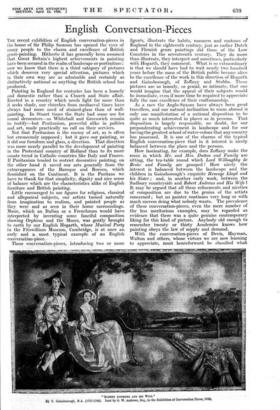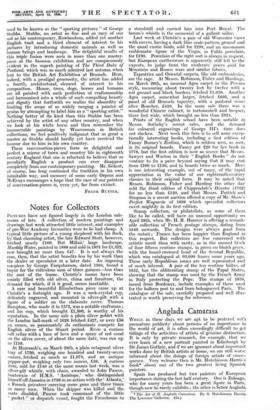English Conversation-Pieces
THE recent exhibition of English conversation-pieces in the house of Sir 'Philip Sassoon has opened the eyes of many people to the charm and excellence of British genre-painting. Hitherto it has generally been assumed that Great Britain's highest achievements in painting have been secured in the realm of landscape or portraiture; now we know that there is a third category of pictures which deserves very special attention, pictures which in their own way are as admirable and certainly as distinctively national as anything the British school has produced. Painting in England for. centuries has been a homely and domestic rather than' a Church and State affair. Erected in a country which needs light far more than it seeks shade, our churches from mediaeval times have always had more need of stained-glass than of wall- painting. In Stuart times the State had some use for mural decorators—as Whitehall and Greenwich remain to testify—but Puritanism, powerful alike in politics and art, made practically no call on their services. Not that Puritanism is the enemy of art, as is often but erroneously supposed ; but it gave our painting, as it did our furniture and glass, a direction. That direction was more nearly parallel to the development of painting in the Protestant country of Holland than to its more ornate trend in Catholic countries like Italy and France. If Puritanism tended to restrict decorative painting, on the other hand it saved our arts generally from the extravagances of the Baroque and Rococo, which flourished on the Continent. It is the Puritans we have to thank for that simplicity, dignity and nice sense of balance which are the characteristics alike of English furniture and British painting. Little encouraged to use figures for religious, classical and allegorical subjects, our artists turned naturally from imagination to realism, and painted people as they were and as. seen in their home surroundings. Music, which an Italian or a Frenchman would have interpreted by inventing some fanciful composition showing Orpheus and the Muses, was gently brought to earth by our English Hogarth, whose Musical Party in the Fitzwilliam Museum, Cambridge, is at once an early and a most typical example of an English conversation-piece. These conversation-pieces, introducing two or more figures; illustrate the habits, -manners and customs of England in the eighteenth century, just as earlier Dutch and Flemish genre paintings did those of the Low Countries in the seventeenth century. They do more than illustrate, they interpret and sometimes, particularly with Hogarth, they comment. What is so extraordinary is that we should have had to wait nearly two hundred years before the mass of the British public became alive to the excellence of the work in this direction of Hogarth and Gainsborough, of Zoffany and Stubbs. These pictures are so homely, so genial, so intimate, that one would imagine that the appeal of their subjects would be immediate, even if more time be required to appreciate fully the rare excellence of their craftsmanship.
As a race the Anglo-Saxons have always been great travellers, and our natural inclination to roam abroad is only one manifestation of a national disposition to be quite as much interested in places as in persons. That disposition is largely responsible, no doubt, for our preponderating achievement in landscape and for our having the greatest school of water-colour that any country has possessed. It is one of, charms of the typical English conversation-piece that in it interest is nicely balanced between the place and the persons. How fascinating, for example, does Zoffany make the room in which Mr. and Mrs. Dutton and Family are sitting, the tea-table round which Lord Willoughby de Broke and Family are grouped I How nicely the interest is balanced between the landscape and the children in Gainsborough's exquisite Heneage Lloyd and his Sister. ; and, in another early work, between the Sudbury countryside and Robert Andrews and His Wife It may be argued that all these refinements and niceties of composition are due to the genius of the artists concerned ; but no painter continues very. long or with much success doing what nobody wants. The prevalence of these conversation-pieces, even the mere number of the less meritorious examples, may be regarded as evidence that there was a quite genuine contemporary liking for this kind of picture. Anybody old enough to remember twenty or thirty Academies knows how painting obeys the law of supply and demand. With the conversation-pieces of Devis, Hayman, Walton and others, whose virtues we are now learning to appreciate, must henceforward be classified what "ROBERT ANDREWS AND las WIFE." By T. Gainsborough, E.A. (1727-1788). Lent by G. W. Andrews, Esq., to the Exhibition of Conversation Pieces, 1930. used to be known as the " sporting pictures " of George Stubbs. Stubbs, an artist as fine and as .raey of our soil as his contemporary, Rowlandson, added yet another English trait and a third element of - interest to his pictures by introducing domestic animals as well as human beings and landscape. The delightful results of this triple- fusion were seen in more than one master- piece at the Sassoon exhibition and are conspicuously evident in the superb painting of The Third Duke of Portland, which was so much admired last autumn when lent to the British Art Exhibition at Brussels. Here, indeed, with a prodigal generosity, the artist has added a fourth, architectural, element of interest to his composition. -House, trees, dogs, horses and humans. are all painted with such perfection of craftsmanship and harmopized into a whole of such compelling beauty and dignity that forthwith we realize the absurdity of limiting the scope of so widely ranging a painter of genius by attempting to label him as a sporting artist." Nothing better of its kind than this Stubbs has been achieved by the artist of any other country, and when we look at his white horse and then remember the innumerable paintings by Wouverman in British collections, we feel positively indignant that so great a master as Stubbs should hardly yet have received the honour due to him in his own country. These conversation-pieces form so delightful and perfect a mirror of town and country life in eighteenth century England that one is reluctant to believe that so peculiarly English a product can ever disappear completely from our contemporary painting. Mr. Sickert, of course, has long continued the tradition in his own inimitable way, and memory of some early Orpens and McEvoys encourages a hope that the race of-our painters of conversation-pieces is, even yet, far from extinct.
FRANK RUTTER.



























































 Previous page
Previous page